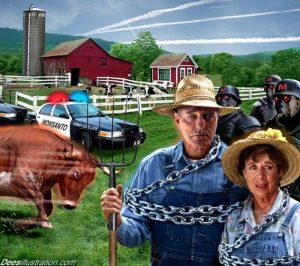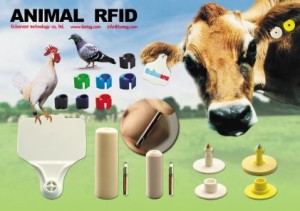July 23, 2009
By Marti Oakley (Food Freedom)
 “The first thing they did when they got the authority to write rules … was to grant themselves the authority to conduct warrantless searches. Wisconsin is in the process of coercing farmers and backyard producers … into NAIS, and the accompanying Premises ID program, by threatening to withhold any of the licenses they control.” Paul Griepentrog
“The first thing they did when they got the authority to write rules … was to grant themselves the authority to conduct warrantless searches. Wisconsin is in the process of coercing farmers and backyard producers … into NAIS, and the accompanying Premises ID program, by threatening to withhold any of the licenses they control.” Paul Griepentrog
In the course of researching various topics, running down leads on information and ferreting out the plans behind the public propaganda used to infringe on one right after another, I sometimes stumble across someone who has so much verifiable information, I am left astounded. This was the case when I happened across a gentleman farmer named Paul Griepentrog while researching the laws and bills about Premises ID and the National Animal Identification System (NAIS).
I already knew the mandatory law had been bought and paid for in Wisconsin through the use of a USDA “cooperative agreement” to the tune of $35 million.
In a recent interview I asked Paul to answer a few questions about what is really happening to Wisconsin residents who are being forced onto these illegal programs:
Q: Does the Animal Health Protection Act of 2003 actually authorize the Animal Identification System or Premises ID?
A: There is nothing in that bill giving them authority to create or establish the National Animal Identification System (NAIS). That law has been misquoted saying that it is the authority for NAIS. We have repeatedly sent letters to USDA and Tom Vilsack asking him to show the section of that law that gives the authority but he refuses to answer or acknowledge the letters.
Q: Has the USDA, in collusion with the Wisconsin AG department, threatened any farms that you know of?
A: Dwayne Brander on behalf of Dr. McGraw, Assistant State Veterinarian, goes out to farms telling them that if they don’t renew or register their premises in the State of Wisconsin they will file suit against them for failing to comply, using the county DA and calling it a civil forfeiture.
Wisconsin is in the process of coercing farmers and backyard producers in an effort to force them onto NAIS and the accompanying Premises ID program by threatening to withhold any of the licenses they control and would refuse to give the license unless you signed up.
Q: Is there a part of the law in Wisconsin that allows for fines and imprisonment based on the sole allegations of these agencies or representative personnel from USDA or DATCP in Wisconsin?
A: Here is section 95 from the Wisconsin bill implementing the “voluntary” NAIS/Premises ID law:
CHAPTER 95
ANIMAL HEALTH
95.23 Disease investigation and enforcement.
95.23(1)
(1) Authorized inspectors and agents of the department may enter at reasonable times any premises, building or place to investigate the existence of animal diseases or to investigate violations of or otherwise enforce the laws relating to animal health. Any animals or materials suspected of being infected may be examined or tested. No person shall obstruct or interfere with such investigation or enforcement work, or attempt to do so, in any manner, by threat or otherwise.
95.23(2)
(2) Upon request of an authorized inspector or agent of the department, sheriffs and police officers shall assist in the enforcement of the laws relating to animal health.
95.99 Penalties.
95.99(1)
(1) Any person who violates this chapter, or an order issued or a rule adopted under this chapter, for which a specific penalty is not prescribed shall, for the first offense, be fined not more than $1,000; and for any subsequent offense fined not less than $500 nor more than $1,000, or imprisoned not more than 6 months or both.
95.99(2)
(2) The department may seek an injunction restraining any person from violating this chapter or any rule promulgated under this chapter.
95.99(3)
(3) A person who violates this chapter or any rule promulgated or order issued under this chapter, for which a specific penalty is not prescribed, may be required to forfeit not less than $200 nor more than $5,000 for the first offense and may be required to forfeit not less than $400 nor more than $5,000 for the 2nd or subsequent offense committed within 5 years of an offense for which a penalty has been assessed under this section. A forfeiture under this subsection is in lieu of a criminal penalty under sub.
~~~~~~~~~~~~~~~~~~~~~~~~~~
Q: Do citizens have the right to demand a full disclosure of the exact laws and basis under which USDA and Wisconsin have charged them? Is there any defense against these attacks?
A: There seems to be none. In the cooperative agreement it states all applicable federal laws shall apply. There are certain major State and Federal Constitutional issues that these laws are in conflict with.
Q: Who exactly is asking for this information?
A: The Department of Agriculture, State of Wisconsin administered by Assistant State Veterinarian, Dr. Paul McGraw; both knowing this has nothing to do with livestock or food safety. This comes from The World Trade Organization and their trade program OIE. http://www.oie.int/eng/en_index.htm World Organization Animal Health.
Q: Where is the information stored? For what purpose?
A: Initially intake is at state level, and then it moves through forms records management plan. There are different steps on how they process this information. From everything I read, a disease outbreak would give state, federal and international interest’s access.
Q: Who is storing the information?
A: Wisconsin Department of Agriculture and then to Wisconsin Livestock Identification Consortium with (WLIC) as final repository in Canada. The WLIC is comprised of various agriculture groups, breed associations and companies selling RFID tags.
Rep. Obey & Sen. Kohl helped to get WLIC started and moved the data base to Canada. The head of WLIC initially was Gary Tauchen who is now a Wisconsin representative and sitting on the house AG committee.
In my own case, I have been registered twice after the fire number on my property changed. Once under the original number and my name and again under the newly assigned number and my farm name; I did not register for Premises ID on either occasion and was signed up without my knowledge or consent.
Q: If the WLIC is listed as the last repository of data mined information, how did files on Wisconsin agricultural properties end up being stored in Canada?
A: WLIC with the help of Rep. Obey and Sen. Kohl although I don’t know for sure how this was accomplished. The intention was to avoid any Freedom of Information Act (FOIA) request or open information requests until they passed the 2008 Farm Bill and included a provision in that bill saying that these files would not be available to FOIA requests.
Q. Who had access to these files when they were outside the country?
A: We don’t know. Once it was outside US jurisdiction we had no way of knowing.
Q: Are you able to get copies of your personal file from the Canadian data bank?
A: I was able to obtain the premises information pursuant to the forms records management plan. To my knowledge I am only the second person to do so.
Q: We know these programs have nothing to do with tracking animal disease and are actually meant to end competition for industrialized agricultural interests, and to seize control of agricultural lands and livestock….who are the actual players that will benefit from these programs?
A: The big corporate industrialized agriculture operators….Cargill, Tyson, Monsanto and others, because they would see the end to competition and obtain virtually full control over all agriculture.
Q: Are Wisconsin politicians either state or federal willing to speak to you about NAIS, Premises ID or the fake food safety bills?
A: On the Federal level, Sen. Kohl and Rep. Obey will not take my calls.
(*Writer’s note: I made my own calls to these offices and when I stated what I was calling in reference to, the staffers got really nasty and then hung up)
In fact Sen. Kohl’s staffer, Kim Cates’ husband is on the Agriculture Consumer Protection Citizen board. He would not even meet with John Kinsman of Family Farm Defenders to discuss the issue.
On the state level are the continuous lies. These people will say Premises ID has nothing to do with NAIS. They say this even though they have been shown the cooperative agreement between USDA and Wisconsin DATCP outlining Premises ID as the first step. They refuse to look at or acknowledge the legal documents.
DATCP had a document on the Wisconsin Legislative information Bureau site saying that the Amish don’t have any problem with this. If the Amish don’t have a problem with it why are they suing Emmanuel Miller Jr., an Amish from Clark County?
Steve Kagen would not address our concerns and he’s on the US house Ag sub- committee that held a hearing on NAIS and is also involved in the food safety bills and won’t address our concerns even there. He is working right now to get funding to move Wisconsin into phase II of NAIS which is the mandatory chipping and tagging of all animals.
I will say that Sen. Feingold has been willing to listen to our concerns both in his Washington office and in the state office.
 Although there is a bill in Wisconsin which would restore voluntary participation I feel it is nothing more than an attempt at political redemption by the same people who passed the mandatory bill to begin with, in that they are fully aware that this bills will be sent to the House Ag committee and never see the light of day. This is merely political posturing…. The house, senate and government are all controlled by Democrats. This may be nothing more than a smoke screen while they make mandatory phase II which is the tagging and chipping, which can’t be done unless you have a Premises ID.
Although there is a bill in Wisconsin which would restore voluntary participation I feel it is nothing more than an attempt at political redemption by the same people who passed the mandatory bill to begin with, in that they are fully aware that this bills will be sent to the House Ag committee and never see the light of day. This is merely political posturing…. The house, senate and government are all controlled by Democrats. This may be nothing more than a smoke screen while they make mandatory phase II which is the tagging and chipping, which can’t be done unless you have a Premises ID.
~~~~~~~~~~~~~~~~~~~~~~~~~~
Paul Griepentrog shows that, in the end, what was billed and sold to Wisconsin farmers and herders as a strictly “voluntary” system turns out to be a mandatory system operated much like a police state enforcement policy. There can be no doubt, especially in light of the hyped up investigation and enforcement policies that this law in Wisconsin is less about disease and more about property seizure and forfeiture.
Wisconsin is the blueprint for the remaining states: what happens there is going to happen to all independent ranchers, farmers and producers across the country if any of these fake food safety bills, or National Animal Identification System (NAIS) is passed into law.
© 2009 Marti Oakley

 A decision by U.S. District Judge Rosemary Collyer, located in the Washington District of Criminals, throwing out a lawsuit brought by Farm to Consumer Legal Defense Fund (FCLDF)
A decision by U.S. District Judge Rosemary Collyer, located in the Washington District of Criminals, throwing out a lawsuit brought by Farm to Consumer Legal Defense Fund (FCLDF) 



 One of the strongest speakers,
One of the strongest speakers,  The USDA has a
The USDA has a 